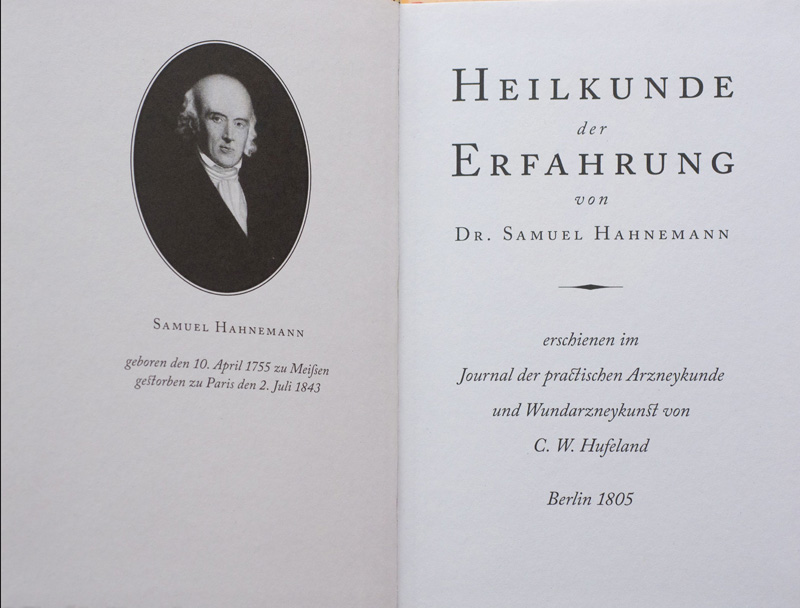Homeopath
Siegfried Letzel
Hahnemann,
the original homeopath
During Dr. Samuel Hahnemann’s stay in Torgau, a new era in his scientific research began: he wanted to move away from a medicine based on conjecture and belief toward a rational medicine that made medical treatment more predictable and reliable. In doing so, he broke completely new ground.
His work in 1796 for his treatise “Essay on a New Principle for Discovering the Healing Powers of Medicinal Substances” was preparatory to this. It was the year that homeopathy was born (although this term didn’t exist at the time!). At that time, he began “to observe medicines and how they affect the human body when it is at the calm level of health.” This meant testing the effects of medicines on healthy people and noting down all noticeable changes in the test subjects. This led to the first principle for the new healing method that was now developing: “Every effective medicine produces a kind of disease of its own in the human body, a disease that is all the more peculiar and severe the more effective the medicine is. Imitate nature, which sometimes cures a chronic disease by introducing another one .” This observation was nothing new. New ailments had often been seen to ‘cover up’ or ‘extinguish’ older ones. He continued: “In the disease to be cured, use the remedy that is capable of provoking another, as similar as possible, artificial disease (= drug disease), and the latter will be cured; Similia similibus .” The word curentur was added much later . This principle of similarity between symptoms of disease and those evoked by medicines had also been discovered by physicians long before Hahnemann. Hahnemann mentions this with examples in his writings. Even the drug proving described here on healthy individuals had been tried long before Hahnemann. But he was the first to successfully combine both, along with drug potentization, into a coherent medical system and to develop it significantly further. This is Hahnemann’s true scientific achievement in the creation of homeopathy.
In 1806, Hahnemann published his “Heilkunde der Erfahrung” (Therapy of Experience), written in Torgau. Here he compiled important empirical principles:
1. When two dissimilar, unnatural, general stimuli act on the body simultaneously, the effect of the weaker stimulus is temporarily canceled out by that of the stronger.
2. When both stimuli are very similar, the effect of the weaker is completely extinguished and destroyed by the analogous force of the stronger.
3. Therefore, to cure, we simply need to counteract the symptoms of the disease with a medicine whose stimulating effect matches the symptoms.
A Torgau house chronicle states: “In 1805, Dr. Samuel Hahnemann bought the house with its driveway on Pfarrgasse to test his homeopathic treatments on the sick and suffering. Since this treatment method was still unknown, it caused a stir that the tiny globules were supposed to be more effective than whole spoonfuls of medicine. But here too, belief prevailed; many were helped, but many were not. He gained enemies and envious people.” Hahnemann’s new medical beginning was extremely difficult to implement. Many things still didn’t fit.
Now he had discovered a new healing principle, and it had to be tested on the sick, further developed, and defended against challenges. To gain a precise picture of the illnesses, he questioned his patients and their relatives/accompanying persons in detail. Then he applied his empirical principles and prescribed only a single, individually selected remedy. He constantly experimented with optimizing the dosage.
In his book ‘What are poisons? In his book What Are Medicines (1806), Hahnemann wrote: “Inappropriate choice, wrong form, and excessive quantity make medicines perishable. This turns them into poisons. Ignorance kills with excess in the wrong place, while the cautious use of the most powerful medicines often saves the most dangerous and rarest diseases. Sapere aude (Have the courage to understand; dare to be wise)!”
In 1807, he had already gone considerably further, concluding an article with the following words: “How little is needed now to realize that the only way to cure diseases easily, quickly, and permanently lies in investigating the entire complex of the symptoms of the disease and in searching for the remedy suitable for each case, which can most completely arouse this complex of symptoms [in the healthy person]?” This remedy should only be administered in the smallest doses in homeopathic use, since it is not ‘the full pathogenic power that is needed, but only its tendency to do so’.
Hahnemann: “I consider myself fortunate to have been the first to draw attention to this most rational and perfect of all healing methods.”
Our association still offers some copies of a reprint (2010) of S. Hahnemann’s ‘Heilkunde der Erfahrung’ from 1805.


